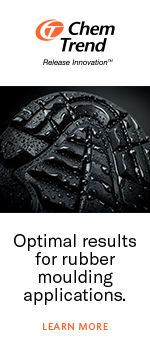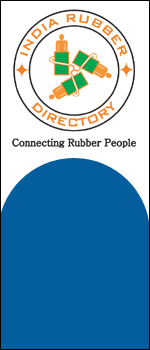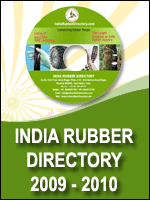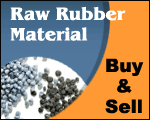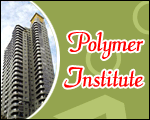Global
Challenges in Rubber Industries Importance of In-house Testing
By Kaushik Mishra
Ceat Research Centre, Ceat Limited, Mumbai
INTRODUCTION
proof of Pudding is in the eating is an old saying. Thus the criterion for
product acceptance is its performance in service. Customer expectations of the
Product are ever increasing. Product liability and competitiveness force
manufacturers to produce articles of consistent quality at right price. Testing
is a tool of utmost importance in achieving these goals, may it be for material,
process or final product.
TECHNICAL REASONS FOR TESTING
1. Rubber is a unusual and complex material. When compounded in a particular way
it exhibits a unique combination of physical properties.
2. It is highly deformable with possibility of complete recovery. Its shear and
Youngs modulii are far higher than the bulk modulus.
3. Even if rubber compounds are made in identical ways, the properties may not
be identical, unlike the behaviour of metal.
4. Conditions and test procedures are of paramount important in rubber testing.
For example, variation in testing speed in a tensile machine may result in a
significant difference in modulus.
5. Test results may differ depending upon the stress history of the test
Specimen.
The above points illustrate the fact that this unusual class of material
requires carefully worked out testing procedure. Methods or philosophy used for
other materials cannot be simply adopted for rubber if meaningful results are to
be obtained.
COMMERCIAL ASPECTS OF TESTING
In India there are a few thousands of small and large scale manufacturers of
rubber articles. Over the years local suppliers of rubber articles have become a
global players with the development of Internet, e-mail, e-commerce and
e-business.
It is hard to believe, but true, that there are many small companies testing the
final product by smelling or chewing by skilled operator or supervisor. A
product manufactured and tested in this manner can never meet customer
expectations. Customer satisfaction is a must to survive in the global market.
Therefore proper testing assumes position of great importance.
CURRENT REQUIREMENTS FOR RUBBER PRODUCTS
1. Better material which means
(a) Longer life
(b) High temperature capability (160ΊC+)
(c) Low temperature flexibility (-40ΊC)
(d) Low permeation rate
(e) Odorless
(f) Reliable long term sealing.
2. More relevant test and better data
(a) Long term (>200 hrs) ageing data
(b) Data for CAE/FEA modeling
3. Global availability
4. Design Support
5. Green Materials should
(a) Be Recyclable
(b) Use Recyclates
(c) Eliminate Toxic/Carcinogenic/Hazardous ingredients
6. Low Price, (for example, China could be a big threat not only for rubber
industries but also for all others).
Let us take specific example of a critical component of a vehicle, such as a
tyre, and understand its global requirements.
|
Features |
Present Situation |
New Demand |
Rolling
Resistance
Tread Wear
Ride (Comfort)
Handing
Dry Traction
Wet Traction |
100
100
100
100
100
100 |
112
110
102
120
120
110 |
There are 500-600 rubber components used in a vehicle and tyre is just one of
them. Therefore it is obvious that each of them component manufacturers has to
take into account a set of features pertaining to the specific article. These
features need to be tested and ensured both while designing and manufacturing.
VARIETY IN TESTING FOR BETTER UNDER-STANDING AND VALUE ENGINEERING
Tests carried out a few years ago are no more adequate because requirement have
changed and additional testing is needed, for example some countries specify the
level of ozone resistance required in the tyres used by them depending on the
environment. Obviously test becomes customer specific, involving more number of
tests. Right product at right cost is the wathword. Naturally selection of
materials, optimization of cost and product performance call of variety of
tests.
TESTING REQUIRED FOR NEW MATREIALS
New raw materials have been developed and are marketed to enhance process or
product performance. A few examples are:
High vinyl content SBR which provides improved wet traction while maintaining
low rolling resistance.
Solution SBR and chemically modified SBR are used for lower rolling resistance
and better wear resistance.
New antioxidants and antiozonants have been developed to improve aged
properties for extended service.
The carbon black and other filler producers have been constantly trying to
develop improved reinforcement materials for better wear and low heat buildup.
To assess the effect of these materials or the product additional tests become a
necessity.
The scope of this Paper is to highlight the importance and critical aspects of
in-house testing. Therefore various test methods will not be touched upon. All
the same, lately Dynamic properties have been useful in developing rubber
compounds and improving performance of components. Here it will be discussed.
Apart from this the different standards, classification of tests etc. will also
be covered.
LIST OF COMMONLY USED
TESTS IN RUBBER INDUSTRY:
Tests on unvulcanised rubber
(a) Visco-elastic flow
(b) Cure Characteristics
(c) Tack
(d) Green Strength
(e) Shinkage
TESTS ON VULCANISED RUBBER
1. Specific gravity
2. Shot term stress-strain properties
(i) Hardness
(ii) Stress-strain]
1. Tensile
2. Compression
3. Shear
4. Flexural/Bending
(iii) Tear
1. Trouser
2. Angle
3. Crescent
(iv) Abrasion Resistance
3. Longterm stress-Strain Properties
(i) Creep
(ii) Relaxation
(iii) Set
4. Dynamic Stress-Strain Properties
5. Fatigue
(i) Flex-Cracking
(ii) Cut growth
6. Effect to Temperature
(i) Heat Ageing
(ii) Thermal Expansion
(iii) Transition Temperature
(iv) Low Temperature Test
1. Recovery test
2. Change in Stiffness
3. Brittleness Temperature
4. Crystallization
7. Electrical Test
(i) Resistance and Restivity
(ii) Surface Changes
(iii) Electrical Strength
(iv) Tracking Resistance
(v) Permitivity and Power factor
8. Thermal Properties
(i) Thermal Analysis
(ii) Specific Heat
(iii) Thermal Conductivity
(iv) Thermal Diffusivity
(v) Surface Heat Transfer Coefficient
9. Environmental Resistance
(i) Thermal Analysis
(ii) Specific Heat
(iii) Thermal Conductivity
(iv) Thermal Diffusivity
(v) Surface Heat Transfer Coefficient
10. Permeability
(i) Gap
(ii) Vapour
11. Adhesion/Corrosion/Staining
(i) To Metal
(ii) To Fabric
(iii) To Cord
12. Safety and Health Regulations.
The above tests can be grouped into three classes depending on the purpose for
which they are used.
(a) Purely for the quality control
(b) For Performance requirement
(c) For development purposes.
For quality control purposes the tests adopted should be relatively simple and
rapid. It is important that the same set of procedures is followed under a set
of defined and precise conditions.
When the focus shifts to performance related tests, unlike tests for quality
control, the conditions are arbitrarily chosen. These conditions should have
relevance to environment of product end use.
In purely research and development area the test conditions will be decided by
the scientists or designers to suit individual requirements.
Irrespective of the the purpose of the tests the individual concerned should be
fully aware of the details and conditions of the tests and it will be his
responsibility to make an intelligent choice.
STANDARDS FOR TEST METHODS AND SPECIFICATIONS.
Generally the source of the standards can be placed into three groups.
(a). International Organization (I.S.O.) The Principle body and the most
important organization in the standards field.
(b). Generally each country has one principle standard organization with
membership of ISO. There may be other organizations also issuing standards at
national level.
Some will known standards are:
C. Individual Companies: There may be many in-house company standards in
existence. These standards appear in commercial contracts. Some of these
standards are also used internationally. For example.
1. MG General Motor Standard
2. Ford Standard
3. Chrysler Standard
The important precaution to be excerised while using Standards is that the user
must refer to the latest edition and must be aware of all the minutes details.
SOME IMPORTANT ASPECTS OF TESTING
Current efforts in the test method development have concentrated on
non-destructive testing. Holographic ultrasonic, infrared radiation, and X-ray
testing as well as nuclear, capacitive, Optical and magnetic guage have been
developed to give an indication of product quality without destroying the
specimen. However, the conventional testing is still very significant and is
being continued in rubber industry.
Let us discuss some important aspects of rubber testing which sometimes we tend
to forget being a routine activity. Before going into details of these aspects,
to understand their importance let us take some practical examples, which
occasionally happen in industry.
1. One Institution in India, which was engaged in evaluating aged properties,
was using an ageing oven without replenishment of air. Obviously, the results
obtained were erroneous and far superior to actual values obtained in other
laboratories with the standard multi-cell ageing oven with right type of air
replenishment provision. One could imagine the problem associated with such
testing and establishing purchase specifications.
2. The second example is concerning a laboratory, which was involved in testing
of ozone resistance when tested in that laboratory, results were more than
satisfactory but in service, ozone cracking was observed with in a short period.
It was finally diagnosed that in the absence of proper calibration of ozone
concentration in the test chamber, 30 pphm was present against 50 pphm
(Standard) required.
Any testing should have the following intrinsic features:
(a) Variability
(b) Accuracy and precision
© Repeatability
(d) Reproducibility
Two examples cited earlier illustrate some of the above features. If the above
aspects are fulfilled the test will be predictable and simulative.
A test is valid if the results are actually a measure of the desired property.
Even though an apparatus and method may be valid, however, the accuracy can be
impaired by either instrumental or procedural errors.
A test is precise if the results are closely reproducible.
Precision of the results within the given laboratory is repeatability and
between laboratories is reproducibility.
Problems of validity, accuracy and precision can cause a wide scatter of data.
Poor resistibility and reproducibility is ultimately the results of variability
in sample history, specimen preparation, inadequate control to test condition,
calibration of test and conditioning equipment, etc.
Let us discuss the above aspects in detail, which matter a lot in testing,
however, these aspects are ignored and neglected often.
1. SAMPME HISTORY:
It is necessary that the rubber samples should not be subjected to high
temperature or other conditions likely to cause deterioration (ozone and other
chemicals) during the storage period.
The limit of storage temperature and humidity should ideally be 10 to 30ΊC and
below 80% R.H.
Different specimens must be sparated to avoid migration of constituents.
Special attention needs to be given when the surface condition of the test piece
is important, for example, ozone or paint staining test.
Acceptable specified Minimum time period between vulcanization and testing is
16 hrs. The maximum of the non-product testing is 4 weeks and for product shall
be 3 months.
2. PREPARATION OF TEST PIECES: In which the following processes are involved:
Mixing of compounds, moulding of Sheet
In mixing of compounds in a two-roll mill of 150-mm dia x 300-mm length
temperature control is required within ±5ΊC.
Tolerance allowed on the weighment of ingredients is 025% or 10 mgs whichever
is greater. The limits on the difference between the sum of the mass of the
ingredients and final mass of the mixed batch is 0.3% for a gum mix and 0.6% for
a filled mix.
The condition and the time of storage between mixing and vulcanization can
affect the properties of the vulcanisate. Hence after mixing, the batch should
be stored in a dark and a dry atmosphere. The minimum time allowed between
mixing and vulcanization is 2 hrs.. Preferred maximum is 24 hrs. and absolute
max is 72 hrs.
Apart from molding temperature (tolerance of which is ±5ΊC), the loading and
unloading of the mould into the press should be done within 45 seconds.
Cutting from the sheet:
To a cut a dumbbell from a cured sheet only a die and a press are required.
There is a tendency to treat this operation as very simple. Without taking much
care. The fact is that, accuracy of the final test results depends considerably
on the accuracy with which the test place was prepared.
It is essential that the cutter is very sharp and free from nicks or uneven
cutting edges, which would produce flaws in the test piece.
The effect of blunt cuts was found to lower the tensile strength by 8%
Poor reproducibility is caused some time by blunt or chipped cutting dies.
These small issues need hours of attention, though generally they are taken for
granted.
Test Pieces From Finished Products:
Some times it is desirable to make the test on actual products for which
cutting or buffing operation is required.
In practice cutting from a large product is often carried out in arbitrary
fashion using variety of knives and hammers. It is suggested both ISO and BS
that cutting should be by a BANDKNIFE LEATHER/RUBBER SLITTING machine. These
machines are precise, extremely efficient.
Buffing is used either for removal of sample irreguarilities or moderate
reduction of thickness. It should not be used for removal of large quantity of
material while preparing the specimen. High heat generation cause sufficient
degradation or rubber surface and properties. A study shows tensile strength is
lowered by 15% on soft rubber and for a tire tread the drop was about 5% when a
smooth surface was obtained by careful buffing.
3. CONDITIONING: Apart from the actual test condition (temperature and
humidity) which are specified for each test in the standard, the properties of
the rubber compounds depend on conditioning of specimen before actual testing.
All the test methods specify the conditioning period, prior to test, in the
standard atmosphere. The objective of conditioning is to brig the test pieces in
equillbrium with the test atmosphere.
Requirement for Conditioning:
Team & Relative Humidity:
a) 23°C & 50% R.H. &
b) 27°C & 65% R.H-> useful for tropical countries.
1. Test where only temp is specified, it should be 23 or 27°C
2. For textiles or composite o textile and rubber the condition should be 20°C
and 65% RH
3. List for testing at sub-ambient temperature is given in the standard.
For all the above standard Tolerance:
±2ΊC on temperature
±5ΊC on RH
Time:
When both temperature and RH are controlled the standard conditioning time is a
minimum of 16 hrs. if only temperature is to be controlled the period is min of
3 hrs. At the subnormal and elevated temperate, it is simply specified that
conditioning time should be sufficient for the test piece to reach equilibrium.
Special cases like
1. After accelerate aging
2. Preparations other than molding like buffing or cutting
3. Mechanical Conditioning.
ISO & BS Specify different conditions periods, which will be available in the
standard.
Apparatus Involved in Conditioning
Air Conditioned room: Rubber conditioning and testing calls for temperature
and humidity control. Therefore, the test room requires air conditioning.
Skipping this necessity for economy reasons will not be advisable because
repeatability and reproducibility of results will be adversely affected.
Hygrometers and thermometers: For humidity control the standard hygrometer
(Wet & dry bulb type) should be kept in a place where air is circulating around
the hygrometer at a velocity of not let less than 3 m/sec. Dry and wet bulb
hygrometer is the most reliable. Some people because of their size and
relatively lower price choose simple AIR OR PAPER hygrometer. They are very
often inaccurate and required calibration regularly.
The standard mercury thermometer is taken for granted as the most accurate,
however, they too need careful inspection for separation of mercury in the bulb.
While measuring temperature, immersion of the bulb to the right depth is to be
ensured.
4. CALIBRATION: is defined as the set of operations which establish, under
specified conditions, the relationship between values indicated by a masuring
instrument or measuring system, or values represented and the corresponding
known values of the measurement.
While all aspects of a laboratorys operations require systematic controls, it
is calibration of the test equipment which gives rise to most of the problems.
It is expensive too. A few years ago all pieces of equipment were not formally
calibrated in most polymer laboratories. It is still not universally accepted
that all the test equipment and every parameter of each instrument require
formal calibration. For example, apart from calibrating the force scale of
tensile machine, there are also requirements for speed of traverse, associated
cutting dies and dial gauges.
Dynamic Testing: let us take an example of Dynamic Testing, which is very much
sensitive to test conditions. All the static tests treat rubber as an elastic
material, where as in fact it is Viscoelastic material. Hence its response to
Dynamic Stressing is a combination of an elastic & viscous response.
Elastic response is required to
Maintain the shape of the rubber article after cyclic deformation. In this
process energy is retained and stored. It reduces heat build up and improves
flex fatigue. In the case of tyres, rolling resistance reduces resulting in fuel
economy.
Viscous response is important to
Dissipate noise and shock vibration in bushings, seals & tyres. Contribute to
the frictional forces required to prevent tyre slippage while cornering. In
viscous behavior energy applied to the body causes deformation and the deformed
body does not return to its original shape. Therefore, the part of the applied
energy gets dissipated and converted in to heat.
Information obtained from dynamic testing:
Resilience: The ration of energy released on recovery, to the energy required
to produce deformation
Hysteresis: Percent energy loss per cycle.
Modulus: ratio of stress and strain under vibratory condition.
Damping: is a result of hysteresis.
Depending upon the Dynamic stressing, tests are divided into three main
categories:
Free Vibration: In which the test piece is set into oscillate and the
amplitude allowed to decay due to damping in the system.
Impact Vibration: Test piece is subjected to part of deformation only.
Falling ball rebound type
Pendulum rebound type
Forced vibration: Oscillation is maintained by external means.
In free Vibration test two well known equipment are:
Yerzley oscillograph it consists of a horizontal beam pivoted so as to
oscillate vertically and in so doing deform the test piece mounted between the
beam and a fixed support. A pen attached to one end of the beam records the
decaying train of oscillation on a revolving drum chart. Yerzley resilience is
calculated from the ratio of two successive decaying amplitudes recorded on the
chart.
Torsion Pendulum- the bottom of a ribbon-shaped specimen is rigidly attached
while the top is fastened, either solidly or throught torsion wire, to a
structure having as adjustable moment of inertia. When the test is performed,
the inertial system is displaced through a small angle and released. The shear
modulus is calculated from the period. Shorter the period greater the modulus.
In impact vibration commonly available equipment are:
Falling ball rebound- if the drop height of a steel ball is divided in to 100
equal parts, the rebound height is equal to the resilience.
Pendulum rebound test- the specimen, held at a rest position of the pendulm
(zero degree), and is impacted by the center of percussion of the arm. The angle
of rebound is followed on a scale and resilience calculated by the formula:
1-cos (angle of rebound)
R = ------------------------------- x 100
1-cos (angle of fall)
The correlation between the rebound tests is very poor. Results are influenced
by plunger weight, design or impacting head, drop height, penetration and
energy-absorbed n the apparatus. In any rebound test the specimen should be
preconditioned with about six impacts before a reading is taken.
Rebound tests are very sensitive to bulk temperature but not to the surface
temperature. Hence conditioning of the samples before testing is very important.
Forced Vibration at resonance
Forced Vibration away from resonance
Constant stress
Constant strain
Another classification could be on the basis of the vibrator used for
oscillating the sample:
Mechanical (force range max 2 Hz)
RAPRA sinusoldal strain machine
Electromagnetic (force range up to 104 Hz)
Closed-loop servo hydraulic (force range up to 100 Hz)
MTS/DMTS (FROM GABO), etc.
The international standard for force vibration measurement is ISO 1464. it
does not specify any particular machine but calls for apparatus giving forced
sinusoidal displacement cycles in shear by means of any of the above vibrator,
the displacement being determined to an accuracy of ±2.5%, tan delta be
measurable to ±5% when the testing is done at 10±0.5 Hz.
No standard gives all details of carrying out the actual tests. This is
basically dependent on the apparatus used. It may be somewhat difficult to
decide which dynamic test machine should be used in a given circumstance this
will depend to a large extent on for what the results are needed and how they
will be used.
One should understand the important criteria for dynamic testing i.e. the
results are dependent on the test conditions, test piece shape, mode of
deformation. Strain amplitude, strain history, frequency and temperature. It is
not sufficient to speak about dynamic test results, unless the details of the
measurement are specified.
CONCLUSION
In this paper we have tried to consolidate our thought in understanding the
importance of some of and how rigidly these aspects are followed in
laboratories. It was not possible to describe the minute details of all the
testing, however, our efforts was to demonstrate what level of importance should
be given to preparatory activities, and test conditions apart from the test per
se, to achieve better product through optimal product design.
REFERENCES
1. RAPRA review: 1992 vol. 5 No. 10,
2. physical testing of rubber: R.P. Brown 2nd edition.
3. Rubber technology: Maurice Morton, 2nd edition.
4. ISO, Guide 25, General requirements for the competence of calibration and
testing laboratories.
5. ISO, 4661, part 1 & 2 Rubber, Vulcanisate, Preparation of samples and test
pieces.
6. ASTM, 1995, Vol. 9.10 & 9.02.
7. Rapra, Polymer testing, 1995.
ACKNOWLEDGEMENT
We express our thanks to CEAT management specifically to Mr. P.K. Mohamed, Mr,
P.V. Alva and Mr. N. Ganesh for their help and encouragement during Preparation
of this paper. I would also like to thank Mr. Ganesh Kamath for his valuable
contribution.










